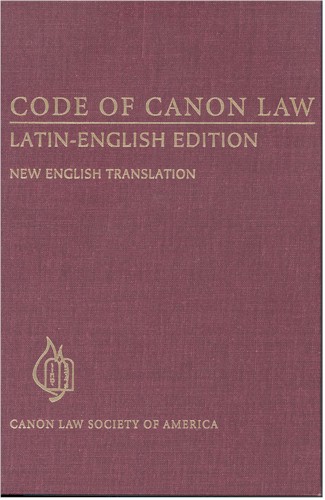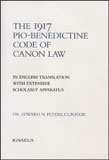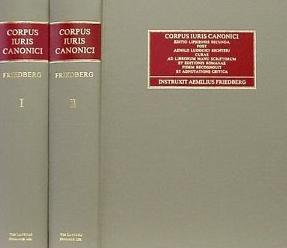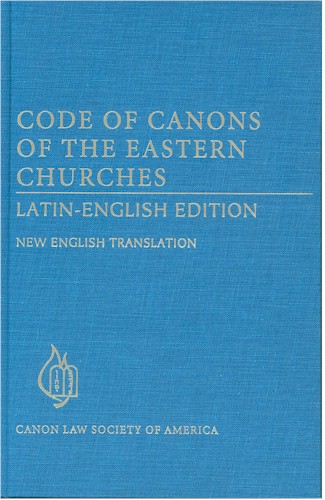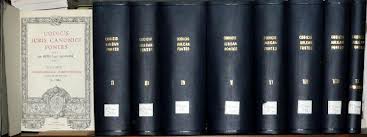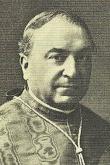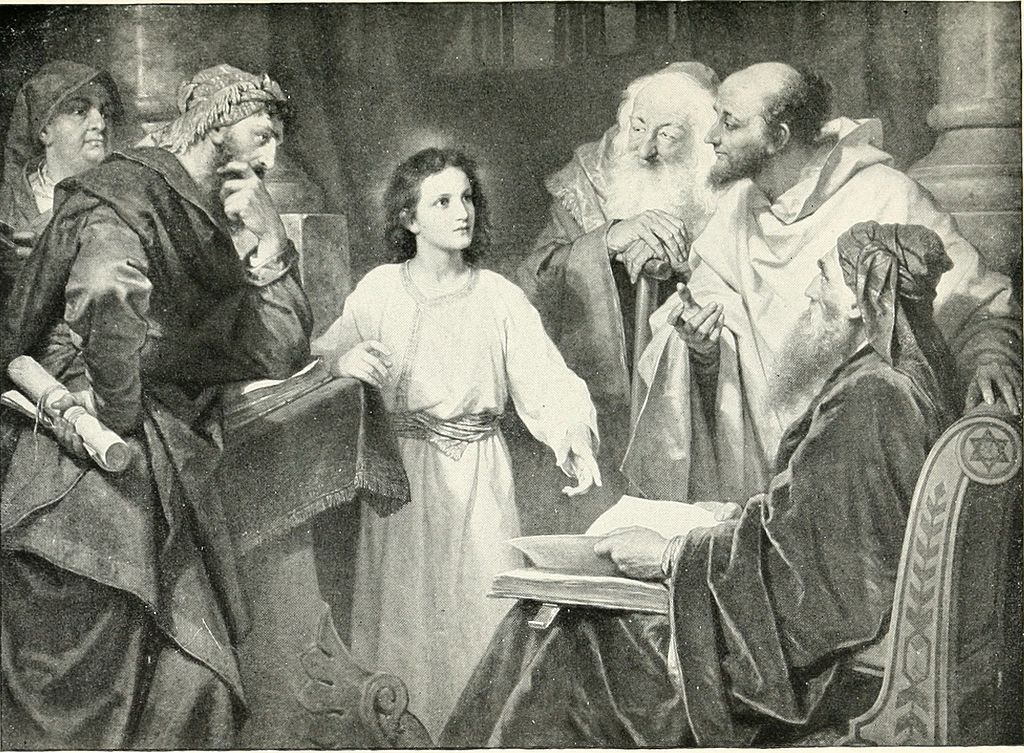| To work for the proper implementation of canon law is to play an extraordinarily constructive role in continuing the redemptive mission of Christ. Pope John Paul II |
|
18 oct 2024 | Masterpage 1917 Code | Research links
|
Resources for studying the 1917 Code in English, here.
Pont. Commission for the Codification of Canon Law, here. |
| Overview
| Master Page on the Pio-Benedictine Code of 1917
The Pio-Benedictine Code of Canon Law was the first integrated code of canon law in the Roman Catholic Church. Ordered by Pope St. Pius X in 1903 and promulgated by Pope Benedict XV on 27 May 1917, taking full force on Pentecost 1918 (19 May), the 1917 Code replaced the Quinque Libri Decretalium (1234) of Pope Gregory IX that had governed the faith life of Roman Catholics around the world for several centuries. The 1917 Code was abrogated on 27 November 1983 when the Johanno-Pauline Code of 1983 took effect.
|
| Text of the law
This work [the 1917 Code], unlike the old Corpus Iuris Canonici (with its Decretum, Decretals, and Supplements), is not a compilation, but a genuine codification–one of the modern world's greatest masterpieces of composition. It's text is in lucid Latin–the only near-universal language. A Panorama of the World's Legal Systems (1936) 966. | Editio typica (official text)
Codex Iuris Canonici Pii X Pontificis Maximi, iussu digestus, Benedicti Papae XV, auctoritate promulgatus, as amended, Acta Apostolicae Sedis 9/2 (1917) 11-521. Original version in Google digitized format here (including footnotes and supporting documentation) and in dispositive text (canons only) here. Numerous monographic printings of the 1917 Code by a variety of publishers appeared over the decades. All of them are textually reliable. Only the Latin text of the Pio-Benedictine Code of Canon Law had force of law.
Translations
No translations of the 1917 Code were authorized during its 65-year enforcement period. Nevertheless two complete Spanish translations appeared as part of commentaries thereon (see Pan-Textual Commentaries
Today the most common English translation of the Pio-Benedictine Code is: Edward Peters (American layman, 1957-), The 1917 Pio-Benedictine Code of Canon Law in English Translation with Extensive Scholarly Apparatus (Ignatius Press, 2001) 777 pp. Order it here. This work, in addition to offering a translation of the complete Pio-Benedictine Code and the eight supporting documents promulgated with it, references all appearances of a given canon in the pages of the Canon Law Digest and offers citations to many English-language canonical doctoral dissertations on a given canon or group of canons.
|
| Canonistics
When referring to a "§" of a canon, I prefer the English word "section" to the word "paragraph" but either term works.
There is evidence that Gasparri considered an ever closer modeling of the projected Code on Decretal law, especially in regard to its use of "titles". See his letter Perlegisiti, translated and commented upon here. | Structure of the 1917 Code: Fundamentally the 1917 Code consists of 2,414 canons, many of which were subdivided into two or more "paragraphs" or "sections" (§) and/or "numbers" (°, or n.). Canons are of equal worth in codified canon law but various means of assessing the relative weight of canons for specific purposes are available.
The canons of the Pio-Benedictine Code were organized into five "books" of equal legal value, namely, General Norms, Persons, Things, Procedures, and Delicts and Penalties. Historians will recognize the influence of the great Roman legal categories (De Personis, De Rebus, De Actionibus) in the structure of the 1917 Code. To some degree, the organization of Decretal law into 'books' and 'titles' was also echoed in the law. Still other subdivisions (with greater or lesser degrees of usefulness) are apparent in the 1917 Code, namely "parts", "sections", "chapters", and "articles", but these subdivisions are of little legal moment.
Most printings of the 1917 Code provided a table of contents, its key promulgating documents, a Profession of Faith (for use with many canons, e.g., c. 1406), Gasparri's famous Preface, and a topical index (see below). Except for the topical index (which functions only in Latin of course) all of these documents are now available in English. Finally, several "Documenta" were re-promulgated as part of the 1917 Code. The reason these documents were selected for simple re-promulgation was never clear. Some of them were abrogated during the enforcement period of the Code but there is no question but that they did constitute law in the Church.
|
|
| Indexes for the 1917 Code: Most monographic printings of the Pio-Benedictine Code have an unofficial topical "Index Analytico-Alphabeticus" developed by Gasparri.
A highly detailed index by (Latin) word is also available, as follows:
• Arcturus Lauer (≈), Index Verborum Codicis Iuris Canonici (Typis Polyglottis Vaticanis, 1941) 936 pp. ▪ Review: S. Kuttner, Jurist 3 (1943) 270-279. Notes: Individual words are presented by canon in which they appear, along with grammatical cases, etc., flagged (but not particularly helpfully).
|
|
| Footnotes to the 1917 Code: Virtually all canons of the 1917 Code were supported by footnotes provided by Gasparri. Although these footnotes are not binding they are of great value in coming to understand the law. These footnotes directed researches to the 6,464 ecclesiastical documents that Gasparri actually used for the 1917 Code (God knoweth how many other documents Gasparri and his small staff had examined) filling more than 7,700 pages in P. Gasparri & J. Serédi, eds., Codicis Iuris Canonici Fontes (Typis Polyglottis Vaticanis, 1923-1949) in 9 vols.
|
| Changes to 1917 Code
| Once the 1917 Code was promulgated it could be officially modified in five ways, namely, by:
• textual correction; • textual modification; • authentic interpretation; • formal instruction; and, • authoritative application.
The 1917 Code has experienced four of these kinds of official changes.
|
| Correction | Corrections to the promulgated text of the 1917 Code were not needed.
|
| One textual emendation was made to the 1917 Code. See Pius XII (reg. 1939-1958), m.p. Abrogatur alterum comma (1 aug 1948), AAS 40 (1948) 305-306., Eng. trans. CLD III: 463-464., derogating from 1917 CIC 1099 § 2 by striking its second part, to wit, the clause "item ab acatholicis . . . acatholica contraxerint".
In the course of the Second Vatican Council, and in the years between its conclusion and the promulgation of the 1983 Code, moreover, many Pio-Benedictine canons were impacted by conciliar and/or papal action. For more information on these special emendations of the 1917 Code, go here. coming.
See also, however, Pio Ciprotti (Italian layman, 1914-1993), Observaciones al Texto del Codex Iuris Canonici [1944], (Consejo Superior de Investigaciones Cientificas, 2° ed., 1950) 208 pp., for numerous suggestions toward revising the text of the 1917 Code, a project mooted by Vatican II and the subsequent complete reform of codified law.
|
| Authentic Interpretation
| Officially binding interpretation of codified law is reserved to the Legislator or to those to whom he commits the authority to so interpret the law. 1917 CIC 17. Establishment of a pontifical interpretation commission was effected by Pope Benedict XV (reg. 1914-1922), m.p. Cum Iuris Canonici (15 sep 1917), AAS 9/1 (1917) 483-484, Eng. trans., CLD I: 55-57. The Code commission decided early on that it would not answer questions from private individuals, but would consider inquiries submitted by ordinaries, major superiors, and so on. See Pontificia Commissio ad Codicis Canones Authentice Interpretandos (Gasparri), De dubiorum solutione (9 dec 1917), AAS 10 (1918) 77, Eng. trans. CLD I: 57.
In the course of its 65-year enforcement period, the Pio-Benedictine Code experienced scores of authentic interpretations. There do not appear, however, to have been any authentic interpretations issued after 1952 until at least the end of the Second Vatican Council (at which point of such activity was more akin to provisional legislation in anticipation of the new Code rather than authentic interpretation of the old.) The best way to determine whether a given Pio-Benedictine norm underwent authentic interpretation is to consult Sartori and Regatillo whose works eclipse all other compilations:
• Cosmas Sartori (Italian Franciscan, 1890-1957), Enchiridion Canonicum seu Sanctae Sedis Responsiones post Editum Codicem I. C. Datae [1926], (Antonianum, 10° ed. rev. by B. Belluco, 1961) 455 pp. ▪ Review: J. Schmidt, The Jurist 22 (1962) 486-487.
• Eduardo Regatillo (Spanish Jesuit, 1882-1975), Interpretatio et Iurisprudentia Codicis Iuris Canonici [1928], (Sal Terrae, 3° ed., 1953) 719 pp.
|
| Instruction
| No Pio-Benedictine canon expressly outlined that canonical institution known today as an "instruction" (1983 CIC 34), but what amounted to instructions regarding various provisions of the 1917 Code occurred with some frequency. For more information on instructions of the 1917 Code, go here. coming.
|
|
Authoritative application | This is my term for an amendment to universal law that does not, strictly speaking, modify the text of the law, nor authentically interpret it, nor even offer an instruction as to how it should be read, but which nevertheless needs to be observed in the application of the law. For more information on authoritative applications of the 1917 Code, go here. coming.
|
| Commentary on 1917 Code
| Codified law in general, and canon law in particular, makes considerable use of private commentary in the elucidation and application of legal norms. The weight to be accorded a private opinion depends less on who authored the opinion and more on the accuracy and completeness with which the views are expressed. The literature that developed under the 1917 Code was enormous and will probably never be completely identified and organized.
Scholarly commentary on the 1917 Code
For insight into the meaning of codified law Pio-Benedictine canonists generally turned first to one or more scholarly, monographic commentaries on the Code as a whole or on larger or smaller parts thereof. See generally:
• Pan-Textual Commentaries on the 1917 Code, here. • Mero-Textual Commentaries on the 1917 Code, here. • Lygo-Textual Commentaries on the 1917 Code, here.
Academic works on canon law
An important category of canonical commentary is the formal academic treatise, i.e., the doctoral dissertation and, to a lesser degree, the licentiate or masters thesis. See generally: International Directory of Academic Works on Canon Law, here.
Peer-reviewed publications
Scholarly articles and reviews appearing in peer-reviewed, academic journals (usually ones dedicated to canon law) play an important part in canonistics. Again, however, this literature is vast. A qualified bibliography of canonical articles (not including monographs!) covering just the first 15 years of the Pio-Benedictine Code ran over 300 pages. See Guiscardus Moschetti (Italian ≈, 1906-1984), Bibliographia Iuris Canonici ex Ephemerides ab a. 1918 ad 1934 (Casa Editrice Libro Italiano, 1942) 335 pp.
Rev. Rhode provides a list of over 40 peer-reviewed canon law journals from around the world, here. Of particular interest to English-reading canonists would be The Jurist (CUA), CLSA Proceedings, Studia Canonica (English and French, St. Paul's Univ., Ottawa) and the GB&I Newsletter.
Some useful canonical materials appear in publications aimed at more general audiences. Of particular interest to English-reading canonists would be articles appearing in, for example, Christifideles, Homiletic & Pastoral Review, America, and so on.
A special category of canonical commentary is the advisory opinion or consultation, a canonical genre similar to the "casus conscientiae" of the moral theologians. Among the most important collections of advisory opinions on Pio-Benedictine law are:
• Edward Mahoney (English priest, 1888-1954), Priests’ Problems, (Burns & Oates, ed. by L. McReavey, 1958) 468 pp. ▪ Review: F. Furlong, Gregorianum 42 (1961) 161. Notes: Not every question and/or answer was strictly canonical, but an index on pp. 459-461 indicates whether a given 1917 Code canon was among the more than 230 canons treated in some 335 main questions. Earlier versions of most of Mahoney's replies can be found be in Clergy Review, 1945-1954.
• William Conway (Irish priest, 1913-1977), Problems in Canon Law: Classified Replies to Practical Questions, (Newman, 1956) 345 pp. ▪ Review: E. Roelker, Jurist 17 (1957) 211. Notes: Earlier versions of most replies can be found be in The Irish Ecclesiastical Record, 1943-1956. ≡ Conway biograph.
• Aa.vv., Consultationes Iuris Canonici, (Pont. Inst. Utriusque Iuris, 1934/1939) in 2 vols. ▪ Notes: Scores of questions on hundreds of canons from throughout the Pio-Benedictine Code.
Other resources
A list of Dictionaries, Encyclopedia, and Reference Works on Canon Law is available here.
|
|
Architect of the Pio-Benedictine Code (1852-1934)
I assure you that during the whole year I would take not one day of vacation, except for Easter Sunday, which was always made up for the following Monday.
See also
G. Osterlé, "Gasparri (Pierre)", DDC V: 939
W. Peters, "Gasparri, Pietro" NCE2 VI: 103-104
| Proto-Codifications and Legislative History of the 1917 Code
At the First Vatican Council (1869-1870), the assembled Fathers called for relief from the plethora of laws under which they were expected to carry out ministry, whereupon the Church began seriously to consider the possibility of codifying her canon law roughly along the lines of the European experiments in civil codification then underway. While that ecclesiastical undertaking had to await the coincidence of a pastoral pope such as Pius X and a canonical genius such as Gasparri, concrete proposals for a code of canon law began to appear in academe. Perhaps the most sophisticated of these was that of Henrico Pezzani (b. 1856), Codex Sanctae Catholicae Romanae Ecclesiae cum Notis, in 3 vols. (Berardi, 1893-1896), although Pezzani's was just one of several models for the eventual project undertaken by Gasparri. See similar efforts by de Luise (1873), Pillet (1890), Russo (1904), and Collomiati (1898-1907). Florent Deshayes, Memento Juris Ecclesiastici (1894/1897) although grouped with the above, was more of a manual on canon law, though much of it would lend itself to use in a code.
A translation of a brief letter sent by then-Abp. Gasparri to faculties of canon law in 1904, requesting their suggestions toward the codification of canon law, along with some brief commentary on the letter, is available here.
Gasparri outlined the history of the codification process in his Prefatio [ad Codicis Iuris Canonici editionem], available in all monograph printings of the 1917 Code, English trans., “Preface [to the 1917 Code]” in my 1917 Pio-Benedictine Code of Canon Law in English Translation 1-19, esp. 10-19. See also:
• A. Stickler, “De efformatione Codicis iuris canonici”, in Alphonse Stickler (Austrian prelate, 1910-2007), Historia Iuris Canonici Latini (Taurinorum, 1950) 376-384, drawing on Cdl. Gasparri’s informal but fascinating reminisces offered in his “Storia della Codificazione del diritto canonico per la Chiesa latina”, in Acta Congressus Juridici Internationalis Romae [1934], in 5 vols., (Pont. Instituti Utriusque Iuris, 1935-1937) IV: 1-10.
• Stephan Kuttner, “Il Codice di diritto canonica nella storia”, Apollinaris 40 (1967) 9-27, Eng. trans., "The Code of canon law in historical perspective", The Jurist 28 (1968) 129-148. • Fascinating talk that describes the mechanics of Gasparri's Herculean efforts and the impact of codification on Church's legal tradition; good remarks on the sacredness of canons, calls for greater use of common law insights in canon law.
• Constant Van de Wiel, History of Canon Law (Peeters/Eerdmans, 1991) 165-174. Order it here.
• Walter Peters, The Life of Benedict XV (Bruce, 1959) 321 pp., esp. 202-212, discusses Benedict's role in the development of the 1917 Code.
Drafts of what would actually become the 1917 Code were published, but were not widely circulated, coming.
|
| User notes | There might be editions of works that pre-date or post-date those cited herein. Reviews and Notes are grey-highlighted, on-line biographical information is underlined blue-linked, and matters in green highlights are of special interest. Yellow highlights are cautions for users, while the markers "=", "≠", and "≈" are placeholders for use by webmaster. |
| Materials on this website represent the opinions of Dr. Edward Peters and are offered in accord with Canon 212 § 3. This website undergoes continual refinement and development. No warranty of completeness or correctness is made. Dr. Peters' views are not necessarily shared by others in the field nor are they intended as canonical or civil advice.
CanonLaw.info Homepage & Site Directory / Help support CanonLaw.info / Original Materials © Edward N. Peters |
| Staging | nabuco, 23 j 253 |
